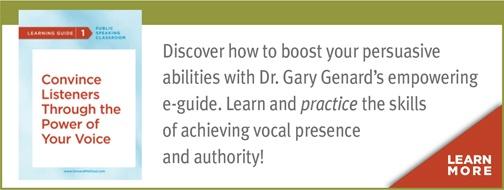Want to captivate business audiences? Learn these two powerful tools of voice and speech improvement to boost your executive presence!
Do you mean business when you speak?
If you’re using your voice to sell, persuade, educate, motivate, inspire, or lead in your industry, you need the best vocal instrument available to ply your trade.
Unfortunately, too few business speakers are performing at this level.
Do you know the essential skills of speaking for leadership? From your message to your voice to inspiring action in listeners, discover how to strengthen your ability to lead when you speak. Download my free cheat sheet, “Leadership Skills: The 5 Essential Speaking Techniques.”
Your business presentation is rarely about content alone—instead, your speech, informal talk, contribution at a meeting and all the rest is an opportunity to influence listeners. That means your audience has to be engaged, interested, and processing what you’re saying in the way you want them to.
Your best tool for accomplishing that in the performance component of your presentation is your voice. But you may be underusing two vital tools that will help you to succeed.
Voice and Speech Improvement Can Boost Your Executive Presence
The tools are pitch inflection and beats. The first may seem so obvious—though neglected—that it’s a can’t-see-the-forest-for-the-trees phenomenon. The second is an actor’s technique that you can and should be using to your advantage.
Pitch Infection Helps Keep Business Audiences Interested. “Pitch” in this sense means highness or lowness on the musical scale. Some people have a voice that’s easy to categorize in these terms (think actors Morgan Freeman for the low end of the scale, and Meg Tilly for the high end). Your position on the scale doesn’t matter too much—what’s important is whether you vary your pitch or use pitch inflection. To learn more about the advantages of the voice, get my free guide on the 5 key tools of vocal dynamics for effective business presentations.
Think of the people you know who have monotonous voices and you’ll understand how important pitch inflection is to a speech. A voice with varying pitch infection is important for two reasons: a) It helps people stay attentive (sameness in any stimulus lulls us into inattentiveness), and b) Pitch is important in differentiating critical points from less important information. To put that another way: how do you separate important content from less vital material if it all sounds the same?
When speakers with good vocal variety want to emphasize something, they usually use a combination of emphasis and pitch inflection. Try it now: Speak out loud something important you want to get across to listeners. . . . Didn’t you just “punch” an important word or phrase and at the same time raise your pitch?
To get an understanding of how well you’re using pitch inflection, tape yourself as you prepare your next business speech. Are you using varied pitch inflection, or does your content roll out monotonously and lifelessly? Imagine the response you’re inspiring in your listeners, one way or the other, and how that affects your executive presence!
Need more on speaking for leadership? Here's my blog on Speaking as a Leader: 12 Ways to Command a Stage.
A Beat Is an Actor's Tool for Effective Presentations. A “beat” is an actor’s term that refers to a character’s intention in a scene. With regard to what the actor is playing, that intention continues until it either accomplishes what the character wants, or it is frustrated. In either case, at that point a new beat begins.
You can see how important understanding a character’s intention is to the actor’s craft. The stronger a character wants something, the more powerfully he or she will respond to what’s happening in a scene. Equally important is the fact that beats change frequently, sometimes moment to moment as the action and conflict with others occurs on the stage or in the film. It’s part of what keeps the character—and the actor’s performance—interesting to the audience.
As a speaker, you have the same need to keep your audience interested. And you can use the very same tool to do so. It's just one of 5 acting techniques for greater stage presence in public speaking .
That's why in my coaching, I use the concept of “beats” as analogous to a speaker’s main points. Each time the main point you're discussing changes, your audience needs to hear that change in your voice. Otherwise, your speech becomes a stringed-out collection of data points that all sound the same. Listeners can't tell where the main segments of your speech lie. Also, audiences need those moments where your talking points (or beats) change, so they can take a mental breath or—if you prefer—hit the “refresh” button in their mind.
How can you use the concept of beats as you prepare your speeches? Simply sit down with your material and note where your main points change, i.e., where you move from discussing one item to the next main item. Now, work on making those transitions clear in vocal terms. To do that, you bascially need to do two things: (1) Pause, then (2) do something different with your voice so your audience hears that new information is coming. And what's your best tool for letting listeners hear that vocally? — That’s right: it’s pitch inflection.
So, pitch inflection and beats. Two simple yet powerful tools for greater executive presence and more successful presentations. Make them part of your vocal repertoire. Believe me, when you use these tools you’ll really sound like you mean business.
You should follow me on Twitter here.



